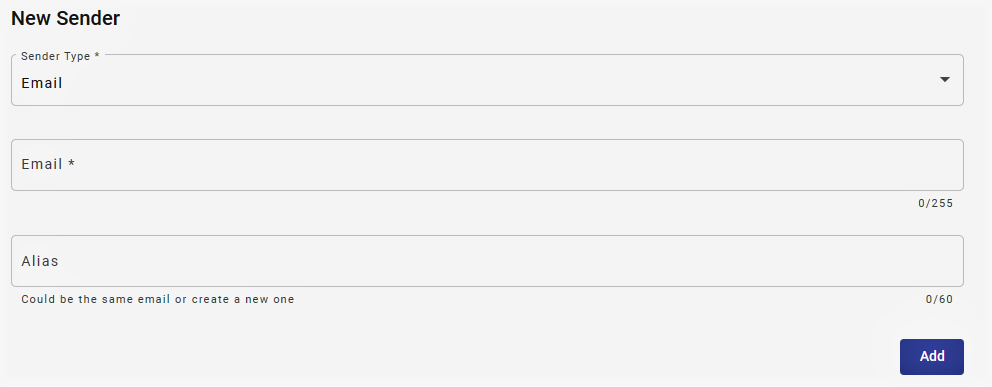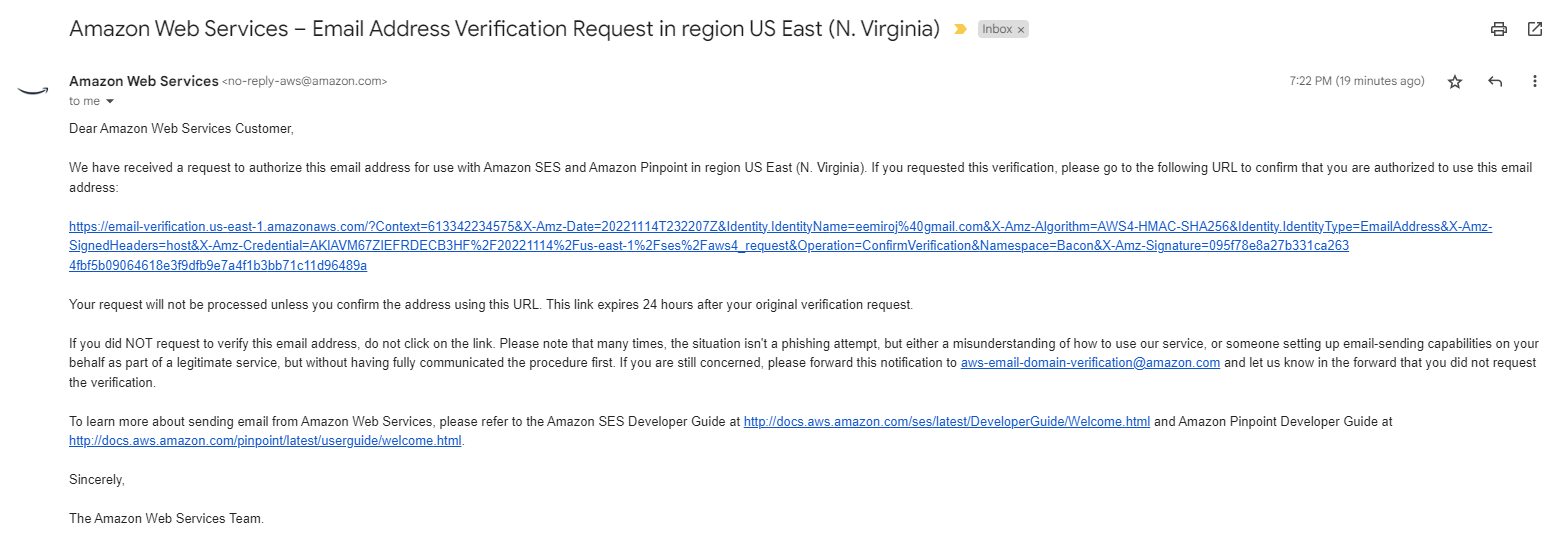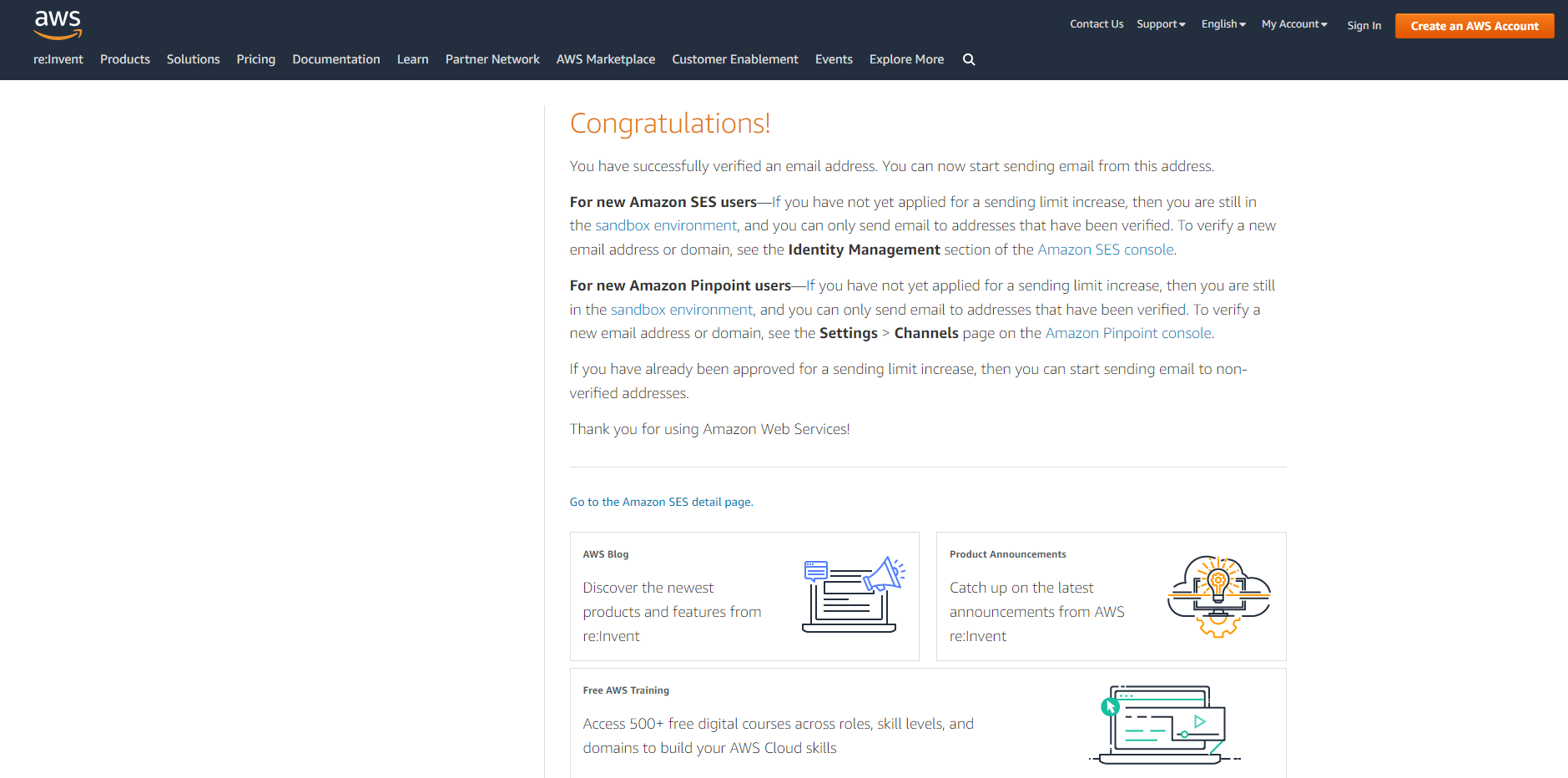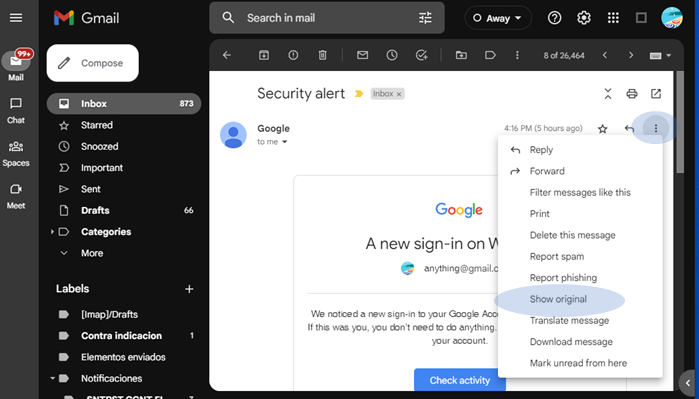Enabling Email
To set up an email channel for platform use, we strongly recommend that you take some time and review the Email Best Practicesbefore you follow these steps.
- Select Add Sender.
- In the new window, select the Sender Type drop-down menu.
- Select Email.

- Fill out the email address and alias fields.
- Select Save.
You will be taken back to the Enabled channels table updated to include the email just added. However, the email channel goes into a pending state waiting to be verified by AWS Email Verification system. Selecting the eye icon of the recently added email channel in the Enabled channels table, you can verify the Pending status in the Sender Details window under the _Status _column.

To activate the email channel for use in the platform, it needs to be verified by Amazon Web Services – Email Address Verification. You will receive an email message from AWS to the email address you just added with an URL. The URL has a validity period of 24 hours (see figure).

Clicking the URL will result in a confirmation message similar to one below, and the added email will become available as one of the platform channels.

To confirm that the email was successfully added to the platform, select the eye icon of email channel and verify that the status has changed to Success as shown below.

If you do not click the URL within 24 hours, the link will expire, the email channel won't be validated, and the Sender Details screen will show a Failed status.

Email best practices
Several factors can lead to your email program's success or failure. Understanding how an email is delivered and following certain best practices can increase your chances of reaching your customers' inboxes. Even when you have customers' interests in mind, you may still encounter situations that impact your messages. The following paragraphs contain some recommendations to ensure your email communications reach your intended audience.
Authentication
- Authenticate your domain with SPF. Sender Policy Framework (SPF) is an email validation standard that prevents email spoofing. Domain owners use SPF to tell email providers which servers can send emails from their domains.
- Sign your outbound mail with DKIM. DomainKeys Identified Mail (DKIM) is an email security standard designed to ensure that the domain owner authorized an email that claims to have come from a specific domain. It uses public-key cryptography to sign an email with a private key. Recipient servers can then use a public key published to a domain's DNS to verify that parts of the email have not been modified during the transit.
ADDING AN EMAIL SENDERWhen adding an email sender to your account, you must contact your account manager or support team to get the TXT Records to authenticate your domain with SPF and DNS Records to sign outbound mail with DKIM.
The procedures for updating DNS records vary depending on which DNS or web hosting provider you use.
- Test your authentication settings. Sending an email to an ISP-based email address you own, such as a Gmail or Hotmail account, and inspecting the original message is one way to verify your domain configuration is correct. In the case of Gmail, you can proceed as follows. After sending the email from the domain you intend to use to your Gmail account, open it, and see if you received the email from your domain. Check the Inbox as well as the Spam folders. If you find the email message you sent from the domain you intend to use, your email is authenticating. Gmail does not accept emails that do not authenticate. You can confirm this by inspecting the details of the email message.
To do this, open the received email message, and on the header of the message, to the far right of the From select the kebab menu (three vertical dots). It will display several options, and you are interested in the Show Original. (See figure below).

This will result in a screen that displays a detailed view of the received message, and most importantly it will display the authentication that was performed on the message and against which domain and IP address. A sample screenshot is shown below.

Note in the figure above that your domain refers to the domain you intend to use for your email messages on the platform. The description above is the desired outcome.
However, if the test email message is not received in your account, it is an indication that the domain is not being authenticated or signed.
Domain and "From" address considerations
- Think carefully about the addresses you send emails from. The "From" address is one of the first pieces of information your recipients see and, therefore, can leave a lasting first impression. Additionally, some ISPs associate your reputation with your "From" address.
- Avoid using a no-reply address, such as [email protected], as your "From" or "Reply-to" address. Using a no-reply@ email address sends your recipients a clear message: that you aren't offering them a way to contact you and that you're not interested in their feedback.
- Ensure that the WHOIS information for your domain is accurate. Maintaining an honest and up-to-date WHOIS record demonstrates that you value transparency and allows users to identify whether or not your domain is legitimate quickly.
Maintain a Clean List
- Implement a double opt-in strategy. When users sign up to receive an email from you, send them a message with a confirmation link, and wait to start sending them emails until they confirm their address by clicking that link. A double opt-in strategy helps reduce the number of hard bounces resulting from typographical errors. This type of organically grown list is the best bet for keeping a healthy subscription list.
- Perform minimal validation on addresses collected with a web-based form. For example, ensure that the addresses you collect are well-formed (that is, they are in the format [email protected]) and that they refer to domains with valid MX records.
- Use caution when allowing user-defined input to be passed unchecked. Forums registrations and form submissions present unique risks because the content is entirely user-generated, and spammers can fill out forms with their content. It's your responsibility to ensure that you only send emails with high-quality content.
- Avoid sending emails to standard aliases (such as postmaster@, abuse@, support@, or noc@). Ensure that you only send messages to real people who want to receive them. This rule is especially true for standard aliases, which are customarily reserved for email watchdogs. These aliases can be maliciously added to your list as a form of sabotage to damage your reputation.
- Periodically purge your list of inactive users to keep your email list and reputation with email service providers healthy.
HARD BOUNCESIt's essential that you monitor the number of hard bounces in your email program, and that you remove hard-bouncing email addresses from your recipient lists. When email receivers detect a high rate of hard bounces, they assume that you don't know your recipients well. As a result, a high hard bounce rate can negatively impact the deliverability of your email messages.
Your account will be suspended from sending more emails when the Bounce Rate is 5% or higher.
Updated 3 months ago
